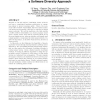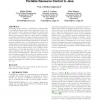158 search results - page 17 / 32 » An Architectural Approach to Preventing Code Injection Attac... |
CCS
2011
ACM
12 years 7 months ago
2011
ACM
The complexity of modern web applications makes it difficult for developers to fully understand the security implications of their code. Attackers exploit the resulting security v...
ICECCS
2005
IEEE
14 years 1 months ago
2005
IEEE
The JavaScript language is used to enhance the clientside display of web pages. JavaScript code is downloaded into browsers and executed on-the-fly by an embedded interpreter. Br...
MOBIHOC
2008
ACM
14 years 7 months ago
2008
ACM
Because of cost and resource constraints, sensor nodes do not have a complicated hardware architecture or operating system to protect program safety. Hence, the notorious buffer-o...
OOPSLA
2001
Springer
14 years 2 days ago
2001
Springer
Preventing abusive resource consumption is indispensable for all kinds of systems that execute untrusted mobile code, such as mobile object systems, extensible web servers, and we...
ACNS
2004
Springer
14 years 1 months ago
2004
Springer
Internet service providers have resisted deploying Denial-of-Service (DoS) protection mechanisms despite numerous research results in the area. This is so primarily because ISPs ca...


